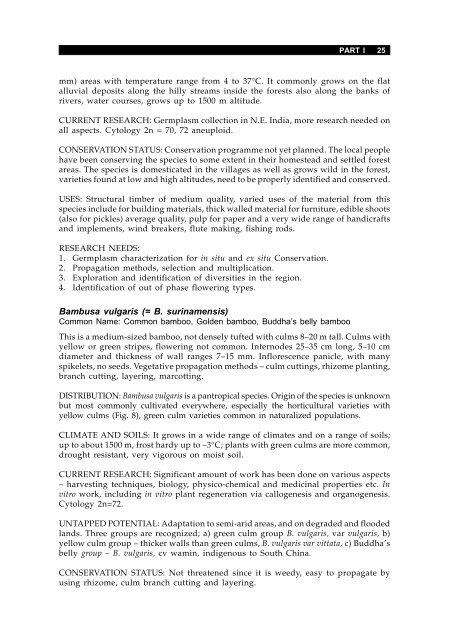Priority species of bamboo and rattan - Bioversity International
Priority species of bamboo and rattan - Bioversity International
Priority species of bamboo and rattan - Bioversity International
You also want an ePaper? Increase the reach of your titles
YUMPU automatically turns print PDFs into web optimized ePapers that Google loves.
mm) areas with temperature range from 4 to 37°C. It commonly grows on the flat<br />
alluvial deposits along the hilly streams inside the forests also along the banks <strong>of</strong><br />
rivers, water courses, grows up to 1500 m altitude.<br />
CURRENT RESEARCH: Germplasm collection in N.E. India, more research needed on<br />
all aspects. Cytology 2n = 70, 72 aneuploid.<br />
CONSERVATION STATUS: Conservation programme not yet planned. The local people<br />
have been conserving the <strong>species</strong> to some extent in their homestead <strong>and</strong> settled forest<br />
areas. The <strong>species</strong> is domesticated in the villages as well as grows wild in the forest,<br />
varieties found at low <strong>and</strong> high altitudes, need to be properly identified <strong>and</strong> conserved.<br />
USES: Structural timber <strong>of</strong> medium quality, varied uses <strong>of</strong> the material from this<br />
<strong>species</strong> include for building materials, thick walled material for furniture, edible shoots<br />
(also for pickles) average quality, pulp for paper <strong>and</strong> a very wide range <strong>of</strong> h<strong>and</strong>icrafts<br />
<strong>and</strong> implements, wind breakers, flute making, fishing rods.<br />
RESEARCH NEEDS:<br />
1. Germplasm characterization for in situ <strong>and</strong> ex situ Conservation.<br />
2. Propagation methods, selection <strong>and</strong> multiplication.<br />
3. Exploration <strong>and</strong> identification <strong>of</strong> diversities in the region.<br />
4. Identification <strong>of</strong> out <strong>of</strong> phase flowering types.<br />
Bambusa vulgaris (= B. surinamensis)<br />
Common Name: Common <strong>bamboo</strong>, Golden <strong>bamboo</strong>, Buddha’s belly <strong>bamboo</strong><br />
PART I 25<br />
This is a medium-sized <strong>bamboo</strong>, not densely tufted with culms 8–20 m tall. Culms with<br />
yellow or green stripes, flowering not common. Internodes 25–35 cm long, 5–10 cm<br />
diameter <strong>and</strong> thickness <strong>of</strong> wall ranges 7–15 mm. Inflorescence panicle, with many<br />
spikelets, no seeds. Vegetative propagation methods – culm cuttings, rhizome planting,<br />
branch cutting, layering, marcotting.<br />
DISTRIBUTION: Bambusa vulgaris is a pantropical <strong>species</strong>. Origin <strong>of</strong> the <strong>species</strong> is unknown<br />
but most commonly cultivated everywhere, especially the horticultural varieties with<br />
yellow culms (Fig. 8), green culm varieties common in naturalized populations.<br />
CLIMATE AND SOILS: It grows in a wide range <strong>of</strong> climates <strong>and</strong> on a range <strong>of</strong> soils;<br />
up to about 1500 m, frost hardy up to –3°C; plants with green culms are more common,<br />
drought resistant, very vigorous on moist soil.<br />
CURRENT RESEARCH: Significant amount <strong>of</strong> work has been done on various aspects<br />
– harvesting techniques, biology, physico-chemical <strong>and</strong> medicinal properties etc. In<br />
vitro work, including in vitro plant regeneration via callogenesis <strong>and</strong> organogenesis.<br />
Cytology 2n=72.<br />
UNTAPPED POTENTIAL: Adaptation to semi-arid areas, <strong>and</strong> on degraded <strong>and</strong> flooded<br />
l<strong>and</strong>s. Three groups are recognized; a) green culm group B. vulgaris, var vulgaris, b)<br />
yellow culm group – thicker walls than green culms, B. vulgaris var vittata, c) Buddha’s<br />
belly group – B. vulgaris, cv wamin, indigenous to South China.<br />
CONSERVATION STATUS: Not threatened since it is weedy, easy to propagate by<br />
using rhizome, culm branch cutting <strong>and</strong> layering.

















